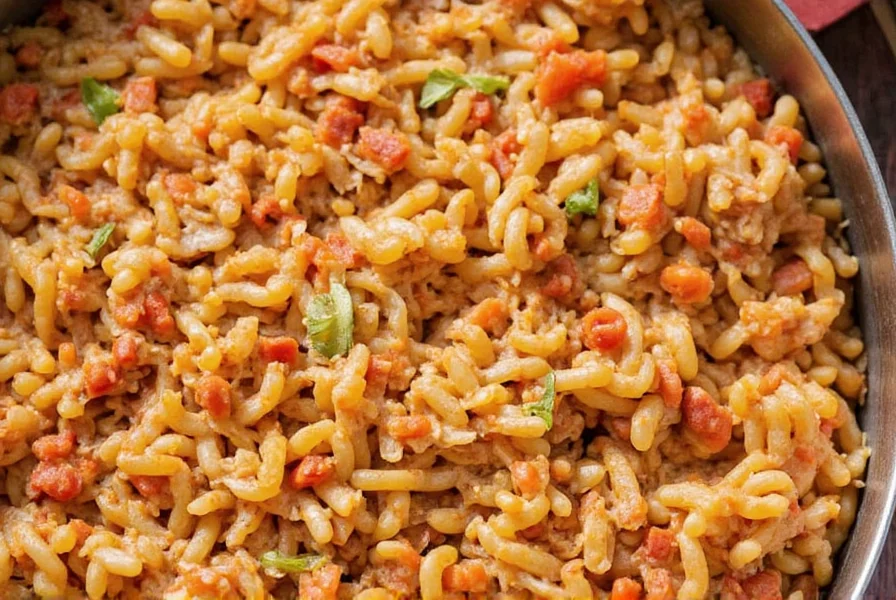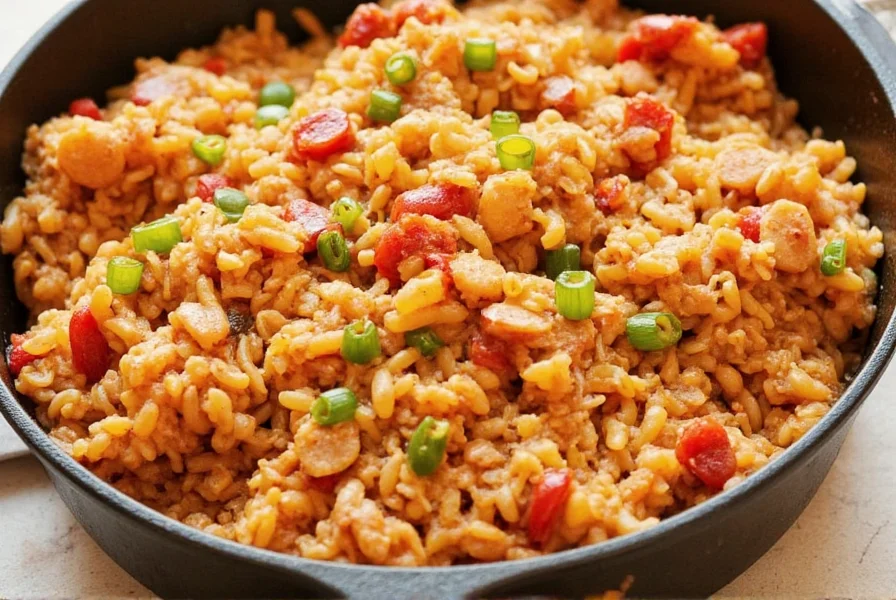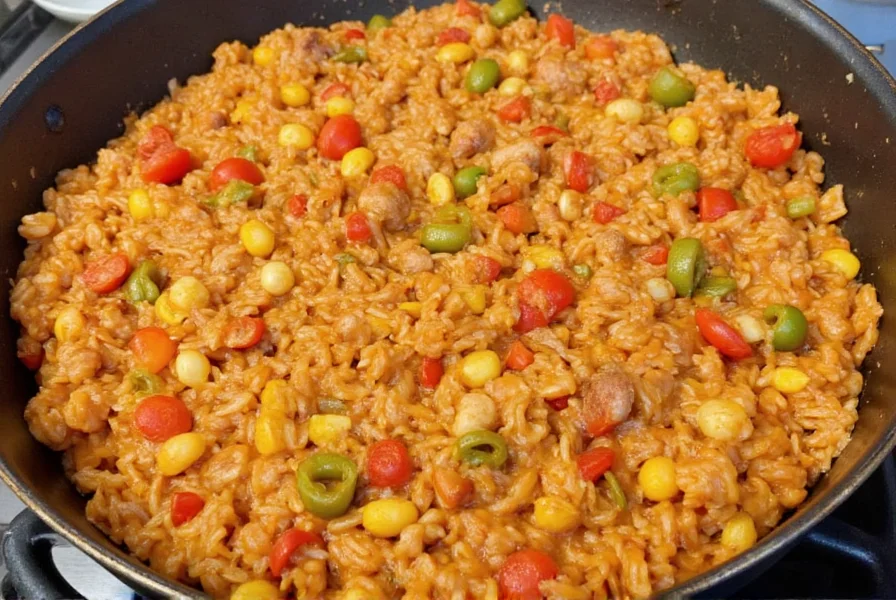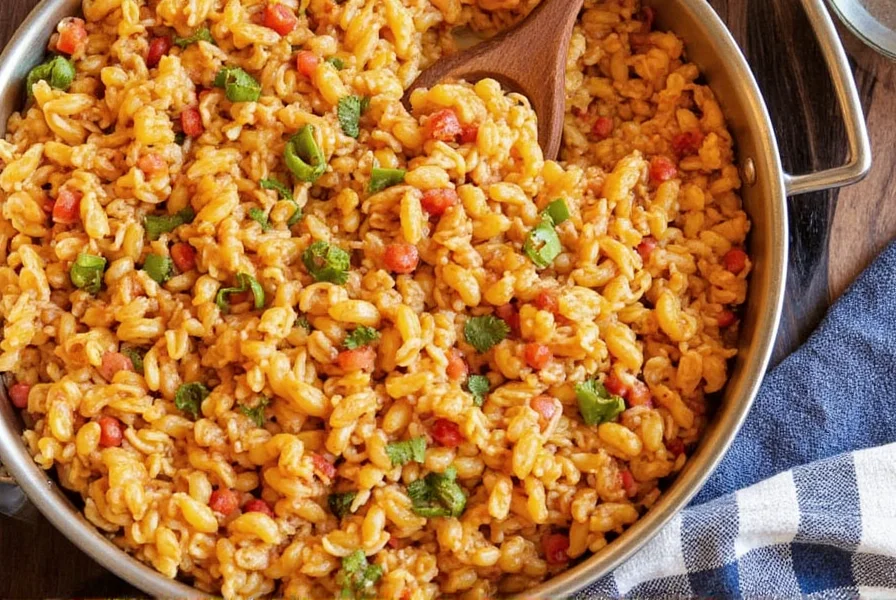Here's how to make jambalaya in 5 simple steps for authentic Cajun flavor at home:
- Saute andouille sausage to render fat and build flavor
- Cook onions, bell peppers, and celery (the Holy Trinity) until soft
- Toast rice with spices for nutty flavor
- Add broth and simmer for 20-25 minutes
- Rest for 5-10 minutes before serving
Below, you'll find detailed instructions, ingredient lists, and pro tips for perfect jambalaya every time.
Table of Contents
- Step-by-Step Cooking Guide
- Key Ingredients for Perfect Jambalaya
- Jambalaya Spice Basics
- Pro Tips for Maximum Flavor & Heat
- A Brief History of Jambalaya
- Buying Guide: The Best Tools & Ingredients
- Frequently Asked Questions
- Conclusion
Step-by-Step Cooking Guide
Now let's get down to business. Here's how to make jambalaya like a seasoned chef:
- Prep Your Ingredients: Chop onions, peppers, celery, and measure all spices ahead of time. This keeps the cooking process smooth.
- Cook the Meat: Sauté the andouille sausage first to render fat and build flavor. Remove and set aside.
- Sweat the Holy Trinity: Cook onions, peppers, and celery in the same pan until soft — don't brown them!
- Add Rice and Toast: Stir in uncooked rice and toast for 2–3 minutes to bring out nutty flavors.
- Season It Up: Add all your spices and stir well to coat everything evenly.
- Pour in Liquid: Add chicken broth (about 2 cups per cup of rice) and bring to a boil.
- Simmer: Reduce heat, cover, and let it cook for 20–25 minutes. Resist the urge to lift the lid!
- Rest & Serve: Let sit for 5–10 minutes, fluff with a fork, and serve hot.
Key Ingredients for Perfect Jambalaya
Here's what you'll need to create a classic jambalaya — with a few optional swaps for customization:
- Meat(s): Andouille sausage (traditional), chicken, shrimp, or even crawfish.
- Aromatics: Onions, bell peppers, celery (known as the "Holy Trinity" in Cajun cooking).
- Rice: Long-grain white rice (like Uncle Ben's or converted brands).
- Liquid: Chicken broth or seafood stock for richer flavor.
- Tomatoes: Diced canned tomatoes (optional for Creole version).
- Spices: As mentioned above — customize to taste.

Jambalaya Spice Basics
The soul of any good jambalaya lies in its seasoning. Here are the essential spices and seasonings you'll want to have in your pantry:
- Paprika – Smoky or sweet? Either works, but smoked paprika adds a depth of flavor reminiscent of slow-cooked meats.
- Cayenne Pepper – For that back-of-the-throat burn. Use sparingly if you're new to spicy cooking.
- Garlic Powder – More consistent than fresh garlic when cooking long dishes.
- Onion Powder – Balances out the other spices without adding texture.
- Dried Thyme & Oregano – These herbs add earthiness and complexity.
- Bay Leaves – Essential for simmering broths and rice dishes.
- Salt & Black Pepper – Don't forget the basics!
- Zatarain's or Tony Chachere's Seasoning – Great shortcut for authentic flavors.
Spice Comparison Table
| Spice | Flavor Profile | Heat Level | Best Use |
|---|---|---|---|
| Smoked Paprika | Earthy, smoky, slightly sweet | Mild | Adds depth to base |
| Cayenne Pepper | Bright, sharp, peppery | Medium-High | Kicks up heat quickly |
| Thyme | Woody, herbal, savory | None | Adds herbal backbone |
| Tony Chachere's | Cajun-style blend with heat | Medium | Ready-to-use convenience |
Pro Tips for Maximum Flavor & Heat
You've got the basic recipe down, but here are some insider tricks to elevate your jambalaya game:
- Toast Your Spices First: Adding spices to a dry pan before wetting the dish can enhance their aroma and depth.
- Don't Over-Stir: Once the liquid is added, minimize stirring to avoid gummy rice.
- Use Homemade Stock: If possible, use homemade chicken or seafood stock for more nuanced flavor.
- Add a Pinch of Sugar: Counteracts acidity from tomatoes and balances spices nicely.
- Let It Rest: Allowing the dish to rest after cooking helps redistribute moisture and flavors.
- Double the Cayenne: Want it hotter? Add more cayenne pepper — or even a dash of hot sauce at the end.

A Brief History of Jambalaya
Jambalaya has roots in Louisiana, where it's considered a signature dish of Creole and Cajun cuisines. While its exact origin is debated, most agree that it was inspired by Spanish paella but adapted to local ingredients like andouille sausage, tomatoes (in Creole versions), and plenty of heat.

Whether you're Team Red (Creole) or Team Brown (Cajun), there's one thing everyone agrees on: jambalaya should punch you in the flavor zone with every bite.
Buying Guide: The Best Tools & Ingredients
From pots to spices, having the right tools makes the difference between a decent jambalaya and a legendary one. Here's a list of recommended items:
Essential Kitchen Tools
- Cast Iron Dutch Oven – Holds and distributes heat beautifully.
- Large Spoon & Ladle – Ideal for stirring thick mixtures and serving.
- Sharp Chef's Knife – Speeds up prep work for aromatics.
Top Recommended Products
| Product | Description | Best Feature | Target Audience |
|---|---|---|---|
| Le Creuset Dutch Oven | Heavyweight, high-quality pot for slow cooking | Superior heat retention and durability | Home cooks who value longevity and performance |
| Tony Chachere's Original Creole Seasoning | Signature Cajun/Creole spice blend with balanced heat | Convenient one-stop seasoning | Beginners or those short on time |
| Andouille Sausage by Aidells | Smoky, spicy pork sausage made with natural casings | Authentic flavor profile | Foodies looking for gourmet authenticity |
| McCormick Bay Leaves | Whole bay leaves in a resealable jar | Fragrant and shelf-stable | Everyday cooks seeking convenience |
| Uncle Ben's Converted Rice | Parboiled rice for fluffy results every time | Consistent texture and easy to cook | Busy households or novice cooks |
Frequently Asked Questions
What's the difference between Creole and Cajun jambalaya?
Creole jambalaya (often called "red jambalaya") includes tomatoes and is associated with New Orleans, while Cajun jambalaya (often called "brown jambalaya") typically omits tomatoes and has a darker color from properly browned meat and vegetables. Both versions use the Holy Trinity of onions, peppers, and celery, but Creole tends to be slightly sweeter from the tomatoes while Cajun has a deeper, smokier flavor profile.
Can I make jambalaya without meat?
Absolutely! For a vegetarian version, substitute meat with hearty vegetables like mushrooms, eggplant, or zucchini, and use vegetable broth. Add smoked paprika and liquid smoke to mimic the traditional smoky depth that comes from andouille sausage. You can also include tofu or tempeh for protein.
Is jambalaya supposed to be spicy?
Traditional jambalaya has a mild to medium heat level, but the spice level is highly customizable. The base recipe typically includes cayenne pepper and hot sausage, but you can adjust the heat to your preference. For milder jambalaya, reduce or omit the cayenne and use mild sausage. For extra heat, increase the cayenne, add hot sauce, or include diced jalapeños.
Why is my jambalaya mushy or too wet?
This usually happens when too much liquid is used or the rice is overcooked. The ideal ratio is 2 cups liquid to 1 cup rice. Measure carefully, resist lifting the lid while it simmers (which releases steam), and let it rest for 5-10 minutes after cooking. If your jambalaya turns out too wet, return it to low heat uncovered for a few minutes to evaporate excess moisture.
How long does jambalaya last in the refrigerator?
Properly stored in an airtight container, jambalaya will keep in the refrigerator for 3-4 days. The flavors often improve the next day as the spices have more time to meld. When reheating, add a splash of broth or water to restore moisture, as rice tends to absorb liquid as it sits.
Can I freeze jambalaya?
Yes! Jambalaya freezes exceptionally well. Cool completely, store in airtight containers or freezer bags (removing as much air as possible), and freeze for up to 3 months. For best results when reheating, thaw overnight in the refrigerator, then warm gently on the stovetop with a splash of water or broth. You can also reheat from frozen, adding extra liquid and cooking time.
What should I serve with jambalaya?
Classic accompaniments include cornbread (to balance the heat), a simple green salad, or steamed green beans. For a more complete meal, serve with okra or collard greens. A cold beer or sweet iced tea makes a perfect beverage pairing. Don't forget hot sauce on the side for those who want extra heat!
What are the most common mistakes to avoid when making jambalaya?
The top mistakes include: rushing the Holy Trinity (it should be softened but not browned), using the wrong rice (long-grain works best), adding too much liquid, stirring too frequently after adding liquid, and not letting it rest before serving. Also, don't skip toasting the rice and spices – this step builds essential flavor layers that make jambalaya special.
Can I make jambalaya in a rice cooker or Instant Pot?
Yes, but with adjustments. In a rice cooker, follow the same initial steps of cooking meat and vegetables in the cooker, then add rice and liquid at the 2:1 ratio. For an Instant Pot, use the sauté function for the first steps, then pressure cook for 7 minutes with a natural release. Note that traditional stovetop cooking gives better control over texture and flavor development.
How can I adjust the spiciness to my preference?
Control heat at multiple points: use mild or hot sausage, adjust cayenne quantity (start with 1/4 teaspoon and increase to taste), add hot sauce at the end, or include fresh peppers like jalapeños. Remember that heat intensifies as it sits, so it's better to under-season initially and add more spice when serving. For milder versions, balance with a touch of sugar or a dollop of sour cream.
Conclusion
Learning how to make jambalaya is more than just mastering a recipe — it's immersing yourself in a rich culinary tradition full of bold flavors, cultural history, and a whole lot of heart. With the right spices, ingredients, and a little patience, you can recreate this beloved dish right in your own kitchen.

Whether you're hosting friends, impressing family, or simply feeding your own spice-loving soul, jambalaya is a dish that brings people together. So grab your pot, fire up the stove, and let the smells of New Orleans fill your home.










 浙公网安备
33010002000092号
浙公网安备
33010002000092号 浙B2-20120091-4
浙B2-20120091-4